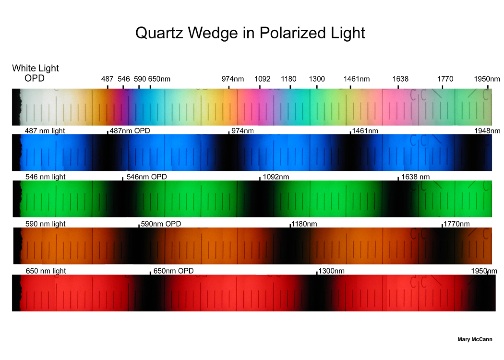Optical Path Differences
in a Quartz Wedge
Optical Path Differences
in a Quartz Wedge

Summary
We have reviewed the papers you sent and made the following summary of our thoughts so far.
1. Introduction: A synopsis of the literature
2. Camera Calibration Experiments: We enclose the digital composite photographs of destructive interference of 15 calibration images using a Nikon 990.

3. Planar Calibration Data:

4. A 3D Calibration Data: See attached.
5. Detailed Notes on references
1.Introduction: A synopsis of the literature
There are four important aspects of the measurement of the thickness of layers creating color fringes. The first is the identification of the wavelength of maximum interference. The second is the calculation of the Optical Path Difference (OPD) from wavelength. The third is the thickness of the layer taking into account the material’s refractive index(n). The fourth is the variation of thickness with eye location.
We used commercial calibrated interference filters to establish the 650, 600, 546, 487 wavelengths (nm). We used crossed polarizers to generate a gradient of interference colors. We calibrated the camera/illuminant response by measuring camera R,G,B (digits) responses . Using this calibration we convert camera digits to wavelengths.
The second issue is the relation of wavelength to Optical Path Difference (OPD). A small percentage of light is reflected from the air-lipid interface and from the lipid-aqueous interface. These two reflected beams interfere and produce the interference colors that indicate the thickness of the lipid layer. The colors are dependent on the phase difference between the two beams.
There is a phase change of /2 upon reflection from the air-lipid interface. There is no phase change of the light reflected from the lipid-aqueous interface. An additional phase difference is introduced by the optical path length traveled by the beam reflected from the lipid-aqueous interface. The thickness (T) of the lipid layer dictates the optical path length traveled by that beam. The refractive index (n) of the lipid layer is approximately 1.48. Since the light reflected from the lipid-aqueous layer traverses the lipid layer twice.
We can write this as:
Optical Path Difference (OPD) = [ 2paths]*[ Thickness T]*[Refractive index (n)]
OPD(wavelength)=2Tn
OPD(wavelength) =[2]*T*[1.48]
OPD(wavelength) =2.96T
OPD between the two reflected rays is approximately three times the film thickness(T), or:
Thickness = OPD/2.96
Surface Plots of Camera Images of Quartz Wedge
in Crossed Polarizers

